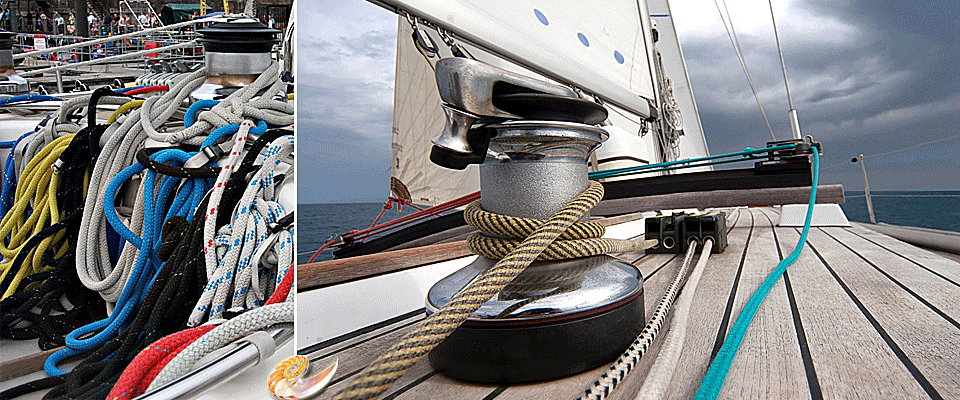
A modern textile rope of a specific diameter can be made to be stronger than a steel rope of the same diameter. Ropes are made either by twisting strands together and then folding these strands to make the required diameter, or they can be twisted and BRAIDED to make either a single braid rope, a double braid, or even a multi-layered braid.
Ropes have been used for millenniums for various applications. Today, ropes are sophisticated and made in many different forms and structures out of high performance fibres.
NAUTILUS BRAIDS only makes Braided ropes.
Braided ropes are stronger, wear better than twisted ropes and generally are much more flexible and user friendly.
Nautilus Braids’ ropes are braided either as a single or a double braid.
We have a range of braiding machines able to make long runs of rope from 0.5mm to 36mm in diameter with 4, 6, 8, 12, 16, 18, 24 and 36-braid constructions.
About Braided Ropes
Single or Double Braid?
All Nautilus Braids’ ropes are either braided as a single braid or a double braid.
Braided ropes have a unique advantage in that the fibres lock tighter together as the load increases. They are stable with respect to twisting because there is no unbalanced twist as found in a laid rope. Twisted, folded or laid ropes untwist as the load increases which tends to loosen the fibre, lowering the inter-fibre friction, allowing the rope to rupture at much lower forces.
The Plaid of the Braid
This refers to the weave or the number of strands that make up each section of the rope. Again engineered to give the highest performance. Centres (inner core) tend to be 8-plaid which gives a tightly compacted central core with the “pitch” (the length of the rope where all the strands have completed one turn) kept relatively long. These are the load bearing fibres and the straighter the better (minimum stretch if the pitch is long – short pitch fibres would act like a spring straightening as the load increases).
The outer cover tends to be either an 8 (especially knobbly ropes for grip) 16, 24 or 36 carrier weave; each weave usually having two or three ends of yarn, depending on the diameter of the rope. So the more finely twisted and the greater the number of filaments, the more resistant to abrasion. However, all ropes have to be spliced and using 16 or 24 carrier ropes with the correct pitch helps this operation, giving the highest strength splice when the weight of the inner core and outer cover are balanced.
Pitch also affects the ease of splicing, and the flexibility and handle of the rope. If the pitch is too short, the rope tends to become hard and loses flexibility; too long and the rope does not wear well. Nautilus Braids has optimised these values for individual rope diameters, balancing the pitch to give the highest performance and best durability, providing easier splicing and the least stretch.
In some special cases, we use Polyarylate or UHMWPE (Ultra High Molecular Weight Polyethylene) in both the inner core and outer cover to provide special attributes such as resistance to heat or friction.
Single Braid
Single braids tend to be used for specialist applications, particularly when strength is paramount. For example, helicopter lifting strops and high performance halyards.
Single braided ropes are formed by braiding together 8 to 10 thin fibres into a tubular braid which means that it is not often perfectly round due to its tubular nature.
Single braid ropes are usually made using high tech fibres – Ultra High Molecular Weight Polyethylene (UHWMPE) or Polarylate/Nylon. When using UHMWPE yarns to make single braids or winch rope, Nautilus Braids coats the finished braid with polyurethane to give protection and durability. The polyurethane can be colour tinted to customer requirements – grey, yellow, red, blue, black and orange.
Double Braid
This structure is the time proven marine standard.
The rope consists of a low twisted compact inner braid, which primarily adds strength, and a twisted braided outer cover which provides strength and abrasion resistance to stand the test of time. The outer yarns are folded in the “S” and “Z” directions, then braided so the individual fibres lie in-line with the rope itself. This stops individual fibres catching on any minor protrusions while in use. While the outer cover adds to the strength of the rope, its primary design function is to give durability and abrasion resistance.
The outer cover also gives the manufacturer the opportunity to add colours to distinguish individual ropes. Nautilus Braids uses colour codes to distinguish our ropes and to indicate the type of inner core used – and from that, we can recommend the application for the rope.
In the double braid structure, Nautilus Braids uses high tech/high strength fibres in the inner core and with the addition of a PE outer cover to give protection from the elements.